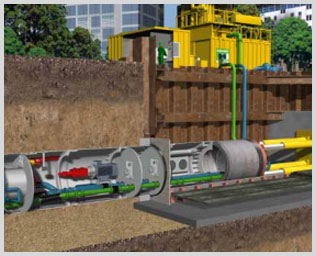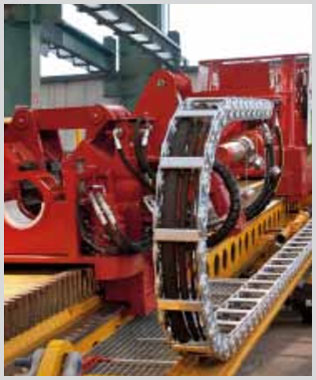Microtunneling
Micro tunneling is used for constructing small tunnels. In most micro-tunneling operations the pipe is inserted from the entrance and pushed behind the machine. This process is often called “Pipe jacking”. As the machine advances, more tunnel liner is pushed from the entrance; thus, the speed of the advancing machine is controlled by the speed at which the pipe is inserted.
These small diameter tunnels make it impossible to have an operator inside the actual boring machine. Instead, the micro-tunnel boring machine (“MTBM”) must be operated remotely. This system is ideal for use in urban areas.
KEY advantages to Micro-Tunnelling/Pipe-Jacking Micro-Tunnelling and Pipe-jacking is reliable and cost-effective.
Key advantages include:
- Minimal earth moving (only for launching & receiving shafts)
- Absence of ground-water lowering (thus preventing dangerous settlements of building foundations and road services)
- Optimal protection for people and nature
- Minimal effect to traffic and pedestrian mobility above ground
- Flexible driving alignment (i.e. curved or linear)
- All-weather construction (thus allowing for rapid completion and meeting deadlines)
- All ground-condition tunnelling (including clay, silt, sand, gravel, and limestone)

Horizontal Directional Drilling
Directional boring, commonly called horizontal directional drilling or “HDD,” is a steerable trenchless method of installing underground pipes, conduits, and cables. Directional boring minimizes environmental disruption. It is suitable for a variety of soil conditions and jobs including road, landscape, and river crossings.
Installation lengths up to 2,000m have been completed, and diameters up to 56” (1,200 mm) have been installed in shorter runs. Pipes can be made of materials such as PVC, polyethylene, ductile iron, and steel, as long as the pipes can be pulled through the drilled hole.
Directional boring is used for installing infrastructure such as:
- Telecommunications & Power Cable Conduits
- Water Lines
- Sewer Lines
- Gas Lines
- Oil Lines
- Product Pipelines
- Environmental Remediation Casings
It is used for crossing waterways, roadways, shore approaches, congested areas, environmentally sensitive areas, and areas where other methods are costlier. HDD is used instead of other techniques to provide less traffic disruption, lower cost, deeper and/or longer installation, no access pit, shorter completion times, added directional capabilities, and overall environmental safety.
The technique has extensive use in urban areas for developing subsurface utilities as it avoids extensive open cut trenches. Uncontrolled drilling can lead to damages of existing utilities, however; so, the HDD method necessitates that the operator has complete information about the existing utilities so that he plans the whole alignment in a way that prevents any damage to them. Different government agencies have established legislation to ensure safe work execution and to authorize such work in urban environments. Different trenchless-technology promoting organizations have developed guidelines for this technique in order to standardize of the techniques.

